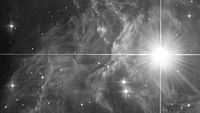RS Puppis
| Observation data Epoch J2000.0 Equinox J2000.0 | |
|---|---|
| Constellation | Puppis |
| Right ascension | 08h 13m 04.21601s[1] |
| Declination | −34° 34′ 42.7023″[1] |
| Apparent magnitude (V) | 6.5-7.6[2] |
| Characteristics | |
| Spectral type | G5-K7[3] |
| U−B color index | 1.2[4] |
| B−V color index | 1.5[4] |
| Variable type | Cepheid Variable[5] |
| Astrometry | |
| Radial velocity (Rv) | 24.60[6] km/s |
| Proper motion (μ) | RA: -3.19[1] mas/yr Dec.: 2.33[1] mas/yr |
| Parallax (π) | 1.91 ± 0.65[1] mas |
| Distance | 1,910[7] pc |
| Absolute magnitude (MV) | -5.70[7] |
| Details | |
| Mass | 9.2[7] M☉ |
| Radius | 194[8] R☉ |
| Luminosity | 17,000[7] (15,000-30,000[9]) L☉ |
| Temperature | 4,500-6,500[9] K |
| Metallicity [Fe/H] | 0.17[10] dex |
| Age | 28[10] Myr |
| Other designations | |
HD 68860, HIP 40233, SAO 198944 | |
| Database references | |
| SIMBAD | data |
RS Puppis (or RS Pup) is a Cepheid variable star in the constellation of Puppis. It is one of the brightest known Cepheids in the Milky Way galaxy and has one of the longest periods of 41.4[7] days.
Because it is located in a large nebula, astronomers using the ESO's New Technology Telescope at La Silla Observatory, Chile have been able to measure its distance in 2013 by strictly geometric analysis of light echoes from particles in the nebula, determining it to be 6500 ± 90 light years from Earth, the most accurate measurement achieved for any Cepheid as of early 2008. The accuracy of the new measurement is important because Cepheids serve as a marker for distances within our galaxy and for nearby galaxies.
Gallery
-
Light echoes from RS Puppis propagate through its reflection nebula
References
- ↑ 1.0 1.1 1.2 1.3 1.4 Van Leeuwen, F. (2007). "Validation of the new Hipparcos reduction". Astronomy and Astrophysics 474 (2): 653–664. arXiv:0708.1752. Bibcode:2007A&A...474..653V. doi:10.1051/0004-6361:20078357.
- ↑ Berdnikov, L. N.; Henden, A. A.; Turner, D. G.; Pastukhova, E. N. (2009). "Search for evolutionary changes in Cepheid periods using the Harvard plate collection: RS Puppis". Astronomy Letters 35 (6): 406. doi:10.1134/S1063773709060061.
- ↑ Gaposchkin, Sergei (1952). "Variable stars in Milton field 38". Annals of Harvard College Observatory 115: 197. Bibcode:1952AnHar.115..197G.
- ↑ 4.0 4.1 Schaltenbrand, R.; Tammann, G. A. (1971). "The light curve parameters of photoelectrically observed galactic Cepheids". Astronomy and Astrophysics Supplement 4: 265. Bibcode:1971A&AS....4..265S.
- ↑ . Bibcode:B/gcvs/. Missing or empty
|title=(help) - ↑ Gontcharov, G. A. (November 2006). "Pulkovo Compilation of Radial Velocities for 35 495 Hipparcos stars in a common system". Astronomy Letters 32 (11): 759–771. Bibcode:2006AstL...32..759G. doi:10.1134/S1063773706110065.
- ↑ 7.0 7.1 7.2 7.3 7.4 Kervella, P.; Bond, H. E.; Cracraft, M.; Szabados, L.; Breitfelder, J.; Mérand, A.; Sparks, W. B.; Gallenne, A.; Bersier, D.; Fouqué, P.; Anderson, R. I. (2014). "The long-period Galactic Cepheid RS Puppis". Astronomy & Astrophysics 572: A7. doi:10.1051/0004-6361/201424395.
- ↑ Moskalik, P.; Gorynya, N. A. (2005). "Mean Angular Diameters and Angular Diameter Amplitudes of Bright Cepheids". Acta Astronomica 55: 247. Bibcode:2005AcA....55..247M.
- ↑ 9.0 9.1 Mayes, A. J.; Evans, A.; Bode, M. F. (1985). "Infrared variability of the reflection nebulosity around RS Puppis". Astronomy and Astrophysics (ISSN 0004-6361) 142: 48. Bibcode:1985A&A...142...48M.
- ↑ 10.0 10.1 Marsakov, V. A.; Koval’, V. V.; Kovtyukh, V. V.; Mishenina, T. V. (2013). "Properties of the population of classical Cepheids in the Galaxy". Astronomy Letters 39 (12): 851. doi:10.1134/S1063773713120050.
External links
| ||||||||||||||||||||||||||||||||||

